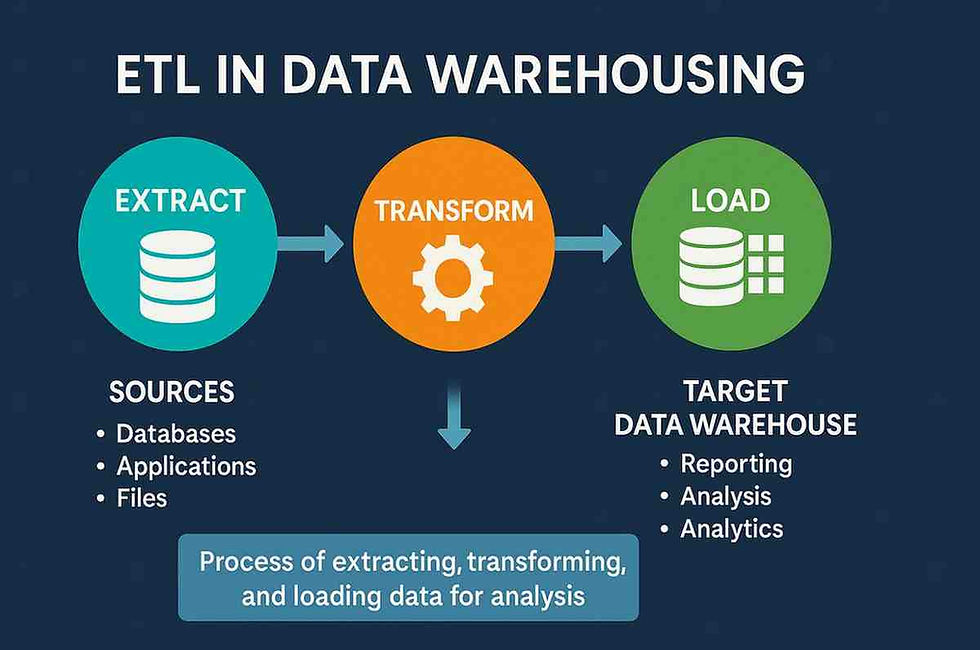ETL Tests Guide: Expert Q&A for Data Warehousing Success 2025
- Gunashree RS
- Jun 26
- 6 min read
Introduction: What Makes ETL Testing Critical for Modern Data Operations?
In today's data-driven landscape, organizations process massive volumes of information daily. The global ETL Testing Service Market is expected to reach USD 3.42 billion by 2033, highlighting the growing importance of robust data validation processes. ETL tests serve as the quality gatekeepers for your data pipeline, ensuring accuracy, consistency, and reliability throughout the extract, transform, and load operations.
This comprehensive guide addresses the most pressing questions about ETL testing through expert insights, concrete statistics, and proven methodologies that industry professionals rely on for successful data warehousing projects.

What Are ETL Tests and Why Do They Matter?
Q: How do ETL tests differ from traditional software testing?
Software testing focuses on validating application features and logic, while ETL testing focuses on the accuracy, consistency, and completeness of data. Unlike conventional application testing that examines functionality, ETL tests scrutinize data integrity throughout its journey from source systems to target destinations.
ETL testing encompasses three primary phases:
Extraction Validation: Verifying data completeness and accuracy during the pull from source systems
Transformation Testing: Ensuring business rules and data conversions execute correctly
Load Verification: Confirming successful data placement in target systems without corruption
Q: What specific data quality issues do ETL tests identify?
ETL tests systematically detect multiple categories of data problems:
Data Completeness Issues: Missing records, null values in required fields
Data Accuracy Problems: Incorrect calculations, format inconsistencies
Data Consistency Errors: Duplicate records, referential integrity violations
Performance Bottlenecks: Slow processing times, memory constraints
According to industry research, the rate at which data is growing has outpaced our ability to examine and organize it, making systematic ETL testing increasingly critical for maintaining data quality standards.
Why Is ETL Test Automation Essential for Modern Data Operations?
Q: What are the concrete benefits of automating ETL tests?
Wayne Yaddow, an independent consultant with over 20 years of ETL testing experience at organizations including J.P. Morgan Chase and Credit Suisse, emphasizes that manual testing is not practical in a highly iterative and adaptive development environment.
The automation advantages include:
Time Efficiency Gains:
Manual testing can take 8-12 hours for complex data validation scenarios
Automated tests complete the same validation in 15-30 minutes
Regression testing cycles reduce from weeks to days
Consistency Benefits:
Manual ETL testing is not sufficiently repeatable for regression testing
Automated tests execute identically each time, eliminating human error
Version control ensures test consistency across development cycles
Cost-Effectiveness Metrics:
Initial automation investment typically pays back within 6-12 months
Long-term maintenance costs decrease by 40-60% compared to manual approaches
Resource allocation improves as teams focus on strategy rather than repetitive tasks
Q: When should organizations prioritize ETL test automation?
The decision matrix for automation includes several key factors:
Scenario | Automation Priority | Reasoning |
High-frequency data loads | High | Daily/hourly processes benefit from consistent validation |
Complex transformation rules | High | Logic verification requires systematic checking |
Multiple data sources | Medium-High | Integration points need comprehensive testing |
Stable data schemas | Medium | Reduces automation maintenance overhead |
Regulatory compliance requirements | High | Audit trails and consistency documentation |
Automating unstable features or features that are changing should be avoided, as frequent test modifications can negate automation benefits.
What Types of ETL Tests Should Organizations Implement?
Q: Which ETL test categories provide the highest value?
Industry experts recommend implementing a comprehensive testing strategy that covers multiple validation layers:
1. Data Completeness Testing
Source-to-target record count validation
Field-level completeness verification
Null value constraint checking
2. Data Accuracy Testing
Business rule validation
Calculation verification
Data type and format consistency
3. Data Transformation Testing
Lookup table accuracy
Aggregation correctness
Data cleansing effectiveness
4. Performance Testing
Load time benchmarking
Resource utilization monitoring
Scalability validation
5. Integration Testing
End-to-end data flow verification
System interface validation
Error handling confirmation
Q: How do organizations prioritize different types of ETL tests?
The prioritization framework considers business impact and technical complexity:
High Priority Tests (implement first):
Financial calculation accuracy
Customer data completeness
Regulatory compliance validations
Medium Priority Tests (implement second):
Performance benchmarks
Data formatting consistency
Historical data integrity
Lower Priority Tests (implement last):
Cosmetic data improvements
Non-critical field validations
Optional business rule checks
Which Tools and Technologies Enable Effective ETL Testing?
Q: What should organizations look for in ETL testing tools?
ETL testing tools have built-in compatibility with cloud data warehouses, ERP, and CRM platforms such as Amazon Web Services, Salesforce, Oracle, Informatica, Kinesis, Google Cloud Platform, NetSuite, and more.
Essential tool capabilities include:
Core Functionality Requirements:
Graphical interface for test design simplification
Automatic code generation for development acceleration
Built-in data connectors for common platforms
Comprehensive reporting and audit trails
Advanced Feature Considerations:
Real-time data monitoring capabilities
Integration with CI/CD pipelines
Cloud-native architecture support
Machine learning-powered anomaly detection
Q: How do organizations evaluate ETL testing tool ROI?
The evaluation framework encompasses multiple financial and operational metrics:
Direct Cost Savings:
Reduced manual testing labor (typically 50-70% reduction)
Decreased defect remediation costs
Faster time-to-market for data products
Indirect Value Creation:
Improved data quality leads to better business decisions
Enhanced compliance reduces regulatory risk
Increased team productivity through automation
Industry data suggests that organizations implementing comprehensive ETL test automation see productivity improvements of 40-60% within the first year of deployment.
How Can Organizations Implement ETL Testing Best Practices?
Q: What implementation approach minimizes risk while maximizing success?
Successful ETL testing implementation follows a structured methodology:
Phase 1: Assessment and Planning (Weeks 1-2)
Current state analysis and gap identification
Tool evaluation and selection
Team skill assessment and training planning
Phase 2: Pilot Implementation (Weeks 3-6)
Select 2-3 critical data flows for initial automation
Develop test frameworks and standards
Create documentation and procedures
Phase 3: Scaled Deployment (Weeks 7-12)
Expand automation to additional data flows
Integrate with existing development processes
Establish monitoring and maintenance procedures
Phase 4: Optimization and Enhancement (Ongoing)
Performance tuning and optimization
Advanced feature implementation
Continuous improvement initiatives
Q: What common implementation pitfalls should organizations avoid?
Based on industry experience, the most frequent mistakes include:
Technical Pitfalls:
Insufficient test data management strategies
Inadequate error handling and recovery procedures
Poor integration with existing development workflows
Organizational Challenges:
Lack of stakeholder buy-in and support
Insufficient training and skill development
Unrealistic timeline expectations
Process Issues:
Inadequate documentation and knowledge transfer
Poor communication between teams
Insufficient change management procedures
FAQ Section
Q: How long does it typically take to see ROI from ETL test automation?
Most organizations see initial returns within 6-12 months, with full ROI typically achieved within 18-24 months, depending on implementation scope and complexity.
Q: Can small organizations benefit from ETL test automation?
Yes, even smaller organizations processing moderate data volumes can benefit from automation, particularly for critical business processes and compliance requirements.
Q: What skills do team members need for ETL test automation?
Teams typically need SQL proficiency, basic programming skills, understanding of data warehousing concepts, and familiarity with testing methodologies.
Q: How do ETL tests handle real-time data processing?
Modern ETL testing tools support real-time validation through stream processing capabilities, continuous monitoring, and automated alerting systems.
Q: What's the difference between ETL testing and data quality testing?
ETL testing focuses on the process of moving and transforming data, while data quality testing evaluates the characteristics and reliability of the data itself.
Q: How often should ETL tests be updated?
Test updates should occur whenever source systems change, business rules evolve, or new data quality requirements emerge, typically monthly or quarterly.
Q: Can ETL testing be integrated with CI/CD pipelines?
Yes, modern ETL testing tools integrate seamlessly with continuous integration and deployment pipelines, enabling automated validation as part of the development process.
Q: What metrics should organizations track for ETL testing effectiveness?
Key metrics include test coverage percentage, defect detection rate, mean time to resolution, automation percentage, and business value delivered.
Conclusion
ETL testing represents a critical investment in data quality and organizational success. Test automation requires initial planning and ongoing diligence, but once technical teams embrace automation, project success is more assured.
Organizations that implement comprehensive ETL testing strategies see significant improvements in data quality, operational efficiency, and business outcomes. The key lies in taking a systematic approach that balances automation benefits with practical implementation considerations.
As data volumes continue growing and business requirements become more complex, ETL testing will only increase in importance. Organizations that invest in robust testing frameworks today position themselves for sustained success in tomorrow's data-driven marketplace.
Key Takeaways
• ETL testing differs fundamentally from software testing by focusing on data accuracy, completeness, and consistency rather than application functionality
• Automation delivers measurable ROI with typical productivity improvements of 40-60% and payback periods of 6-12 months
• Comprehensive testing strategies cover multiple layers, including data completeness, accuracy, transformation logic, performance, and integration validation
• Tool selection should prioritize compatibility with existing platforms and include graphical interfaces, automatic code generation, and built-in connectors
• Implementation success requires structured approaches with phased deployment, stakeholder buy-in, and adequate training investments
• Common pitfalls include inadequate planning, insufficient skill development, and poor integration with existing development workflows
• Market growth reflects increasing importance, with the ETL testing service market expected to reach $3.42 billion by 2033
• Real-time capabilities are becoming standard as organizations require immediate data validation and continuous monitoring
• Team skills should encompass SQL proficiency, programming fundamentals, data warehousing concepts, and testing methodologies
• Continuous improvement is essential with regular test updates, performance optimization, and adaptation to changing business requirements




INDOVIP138
indovip138
indovip138
indovip138
indovip138
indovip138
indovip138
indovip138
indovip138
indovip138
indovip138
indovip138
indovip138
indovip138
indovip138
indovip138
indovip138
indovip138
indovip138
indovip138
indovip138
indovip138
indovip138
indovip138
indovip138
indovip138
indovip138
indovip138
indovip138
indovip138
indovip138
indovip138
indovip138
indovip138
indovip138
indovip138
indovip138
indovip138
indovip138
indovip138
indovip138
indovip138
indovip138
indovip138
indovip138
Link INDOVIP138
indovip138
indovip138
indovip138
indovip138
indovip138
indovip138
indovip138
indovip138
indovip138
indovip138
indovip138
indovip138
indovip138
indovip138
indovip138
indovip138
indovip138
indovip138
indovip138
indovip138
indovip138
indovip138
indovip138
indovip138
indovip138
indovip138
indovip138
indovip138
indovip138
indovip138
indovip138
indovip138